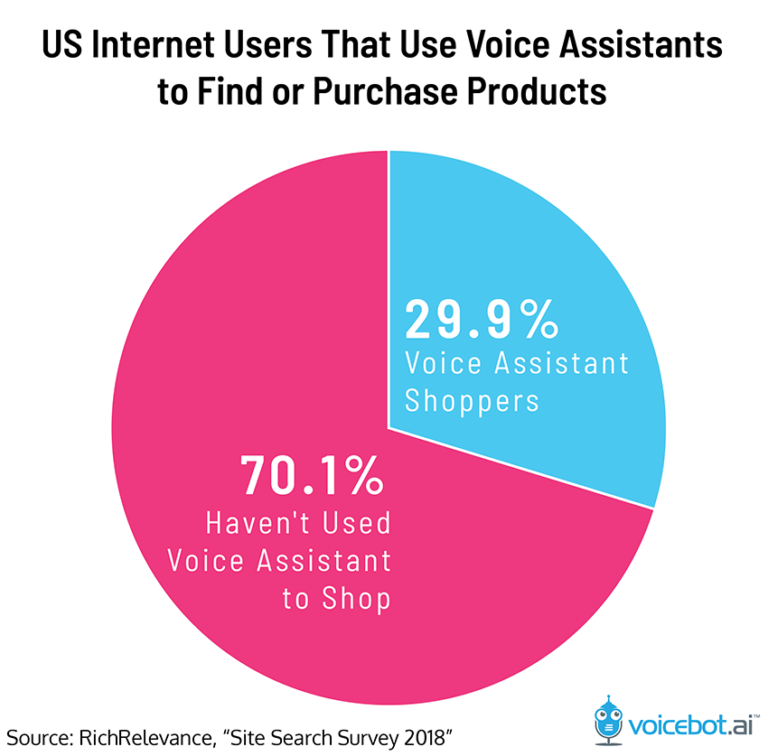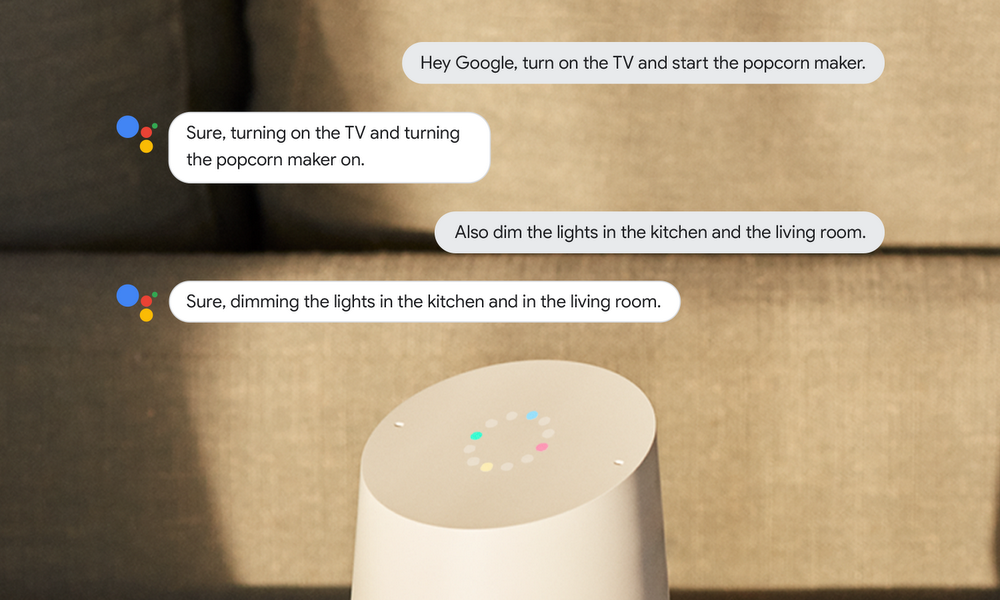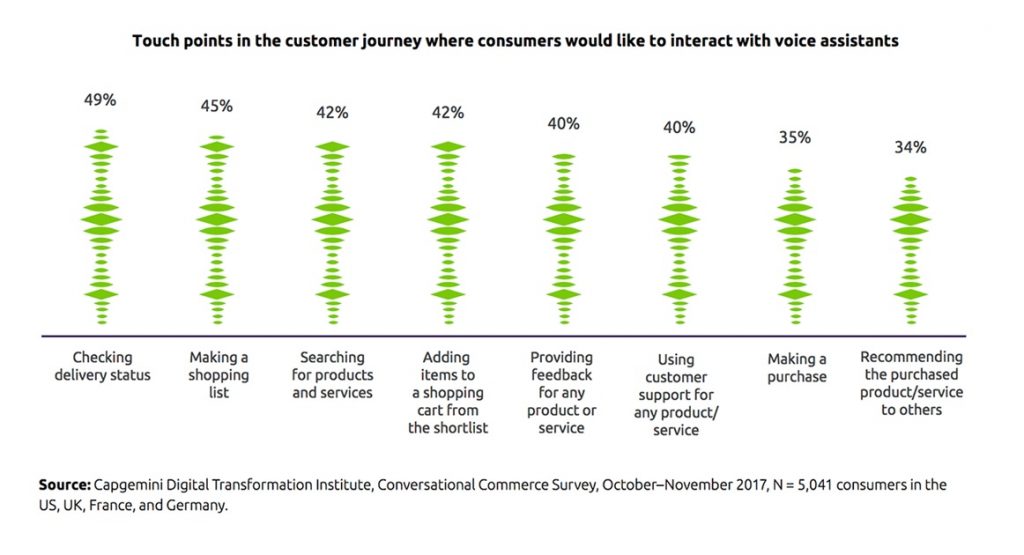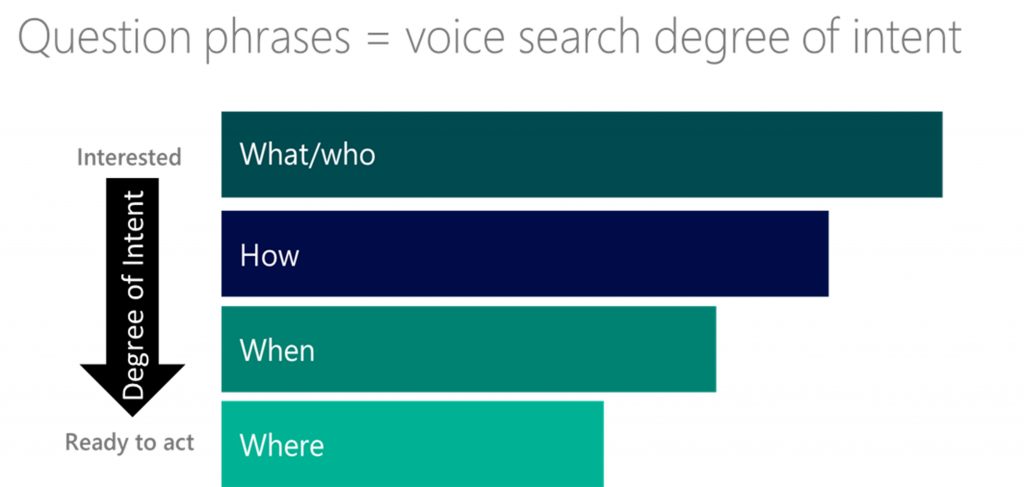From the advent of the mobile to smartphones and talking on the phone to talking ‘to’ it, we have come a long way.
‘Hey Siri’, ‘Ok Google’, ‘Alexa’ are now a part of our day to day lives. Voice assistants have changed our relationship with smartphones from being a communication device to being enablers of simplifying some of our daily tasks.
Voice searches and voice assistants have piqued users’ interest over the years. According to Gartner, about 30% of all searches will be done without a screen by 2020 and as per Comscore, 50% of all searches will be voice searches.

Image source: https://voicebot.ai
Contents
- 1 How consumers are using voice assistants
- 2 The reasons behind the low adoption of voice assistants for shopping
- 3 Why should brands consider devising a strategy for voice-assisted shopping?
- 4 What consumers expect from voice assistants
- 5 So what should brands be doing now to get ready for the voice shelf?
- 6 How retailers can make the most out of the voice-search
- 7 In conclusion
How consumers are using voice assistants
According to a study, 35.8% of millennials use voice-enabled digital assistants at least once a month. While we have seen consumers using voice assistants and slowly becoming comfortable with the technology, is it something that retailers should concentrate on right away?
To answer that question let’s see how consumers are using voice assistants:

Here is how consumers are using voice speakers:
A recent report by Comscore suggests-
- 60% use them to ask general questions
- 57% use them to get weather report and stream music
- 16% use it to find local businesses
- 11% use it for ordering products &
- 8% use it for ordering foods and services
The above statistics point out that a very small percentage of consumers are using their voice devices for shopping. Further, a majority of Americans (70%) have not yet used voice search or voice assistants to shop, and well over half don’t trust the current providers to get it right.

Even when shoppers are using voice assistants the highest percentage of people use it for researching or managing their shopping lists than actually making a final purchase.

Image source: https://voicebot.ai
Currently, among the users who use voice search to shop, Google Assistant leads Amazon Alexa (14% vs. 9%). However, these consumers also feel that these players haven’t got voice-assisted shopping right. A study suggests that almost 63% of consumers feel that none of the current leaders (Amazon, Apple, Google, Microsoft) will pull ahead and “get it right,” any time soon.
There is obviously a gap that the consumer is facing when it comes to using voice assistants while shopping. As per a recent study, these are the three major reasons why consumers are reluctant to use voice-assisted shopping.
- The technology is new
- Lack of personalization
- Not a simplified experience
Let’s dig deeper into each of these.
The reasons behind the low adoption of voice assistants for shopping
The technology is relatively new
Smartphone is an integral part of the consumer’s life today. While consumers are searching on smartphones they are not shopping on the device. Almost a third of shoppers (29 percent) browse on their smartphones daily, but only 27 percent of those shoppers go on to make a purchase on their devices at the same frequency.
The issue is, it’s more of a habit or muscle-memory in play here. While shopping, people tend to browse items, read reviews, compare costs etc. before making a purchase, these are things that cannot be done on voice-based assistants. It’s a habit that is very difficult to change. Of course, it’s possible to add shopping items to your list via voice but it works for items that you commonly use and ones that don’t need research or reviews from other users.
‘’Meeker’s 2015 report bets on ‘Buy buttons’ on social media to drive e-commerce but that has not happened yet. The incumbent e-commerce players are still the king and will remain so in the near future. I think voice assisted shopping might face a bit of resistance from IoT powered shopping such as the Amazon DASH buttons. For repeated purchase of consumables, one-press buttons are much faster and efficient than voice-based shopping. Even though the speech recognition has improved up to human-level accuracy I think people still have to build a habit of using speech to perform tasks on their phones.’’
-Pradeep Kumar, Vice President, Technology Innovations, Robosoft
The overall adoption of voice technology when it comes to retail is still picking up. One of the biggest reasons for this is the lack of interaction with the actual product on a digital platform vs in-store.
In case of voice assistants, the added disadvantage is the lack of screen as well. When it comes to consumables or CPG products like grocery items, it is relatively easier for buyers to shop for them. However, buying higher value products or apparels without a screen is not comfortable for users.
As per Tiffany Tan Kohler, Director, brand engagement, The Clorox Co.
‘’People use voice commerce, specifically, for consumables and reordering products they are familiar with. The beauty of voice is that it enables frictionless shopping, so it’s particularly ideal for buying consumables that shoppers think about during their day.’’
Of course, this challenge opens up possibilities for brands to experiment with technologies like Virtual Reality. Technology giants like Amazon are already thinking ahead and tackling this problem, last year, Amazon launched its Echo Show that provides users with a screen to better see purchases and other images.
‘’I think voice assisted flows will find more use in much simpler tasks where there are not a lot of options to choose from. It’s better suited for flows that are complex to be performed via click or taps but can be done easily via voice command. This can still be applicable to shopping for products that don’t have a lot of configurations.’’
-Pradeep Kumar, Vice President, Technology Innovations, Robosoft
Missing the connect
Most of the voice assistants need to be given exact and specific instructions. However, while shopping consumers are not always clear about the brand they want to buy, in some cases even the product category they want to buy.
According to a study, most website/mobile app visitors actually spend time researching about a product category than buying, further proves that purchase is typically a secondary consideration. In fact, even when it comes to shoppers who say purchase is their primary reason for visiting websites/mobiles apps, just 38 percent first look for the products they came for.
This means most online shoppers are usually looking for recommendations. The voice assistants available in the market today aren’t able to connect with the consumers. A recent study, suggests, 72% of respondents feel that the voice assistants are not cognitive enough to recommend gift ideas. However, as technology advances retailers will be able to personalize customer experiences.
Google Duplex is an example of one such advancement in this area and is a big step towards humanizing the voice assistants. The recent launch of Continued Conversation, a feature that allows for more natural conversation between users and Google Home voice assistants is another critical step towards making conversations with a voice assistant sound more natural.
As per Google
We’ve heard from a lot of people that adding “Hey Google” before each follow-up question for the Assistant doesn’t feel as natural as they’d like. We announced Continued Conversation at I/O as an optional setting which lets you have a natural back-and-forth conversation with the Assistant without repeating “Hey Google” for each follow-up request.

Image source : blog.google
The factors responsible for personalizing these experiences for customers are two-fold:
- First, AI and NLP (Natural Language Processing) will need to advance to a point where consumers feel that they are interacting with a human voice at the other end.
- Second, retailers will have to devise a strategy to ensure the device has the latest customer interactions so it can make targeted, on point recommendations that align with the shopper’s current sentiment and previous behavior.
Not a simplified shopping experience
With the advancements in the technology and digital payments, the entire purchase-cycle for online purchases is integrated. However, the ease of payments hasn’t been sorted out when it comes to voice-assisted shopping. As per a recent survey, almost 19% of respondents felt that voice commerce required too much guidance.
When it comes to voice-commerce it is important that users get the convenience of making the purchase in minimal voice-commands and zero screen interaction. Much like in the case of mobile apps it is important that the entire purchase cycle from researching to payments is completed in a limited number of fingertips.
As per Bill Carmody Founder and CEO, Trepoint
‘’If voice commerce is not easy to navigate when making a purchase, users will unplug and move to another channel. Regardless of the channel consumers engage on, they want it to be convenient and that’s a major benefit of an in-home assistant.’’
One important thing that brands need to know if they want to be part of the voice assisted shopping is that their names should be easily recognizable by the NLP engines. Products that have common names might be easily recognizable but products that have a tough name or can be pronounced in different ways will have trouble getting it right. Identifying the brand name via voice recognition is the first challenge that brands will have to face and solve.
Why should brands consider devising a strategy for voice-assisted shopping?
While the technology itself seems to be in a nascent stage, it will advance with innovations and improvements in the area of AI, NLP, AR/VR etc. For brands, to stay ahead of the curve, it makes sense to start exploring the possibilities now, when the technology is still picking up and the adoption is easier.
Further, today’s digitally-savvy consumers seek technology-rich experiences, provided they are done right. According to a recent report by Capgemini–
40 percent of consumers say that three years from now, they will be more likely to use a voice assistant rather than engage with a retailer’s mobile app or website. That’s up from 24 percent who use or would use the technology today. The study also found consumers expect to be using voice assistants over a number of other retail tasks within three years, including visiting a shop, dealing with customer support/call centres and using a salesperson.
However, while consumers are open to trying a new technology, they are equally fast to abandon an experience that doesn’t add value to their digital experience and isn’t intuitive enough. Hence, it is important for brands to have a clear strategy on why they should have a voice-search strategy and how is it going to make consumer’s life easier.
As Joey Moore, director product manager, Episerver, rightly puts it:
“Today’s shoppers are interested in technology-rich experiences, but only if it’s done right. Rather than introducing novel technology for the sake of doing so, brands should implement tools like smart mirrors in-store and facial recognition sign-in online to make shopping easier, fast, more convenient and engaging.”
What consumers expect from voice assistants
Convenience is one of the major reasons why consumers adopt any new technology. So, is the case with voice assistants too. As validated by a recent report, 52 percent of consumers say convenience and 48 percent consumers say the ability to do things hands-free, are the two biggest reasons for preferring voice assistants over mobile apps/websites. Further, being able to automate routine shopping tasks and a higher level of personalization was tied for third, at 41 percent.
When it comes to shopping consumers would want a voice assistant to make their lives easier at various touch points.

So what should brands be doing now to get ready for the voice shelf?
It is clear that consumers are expecting retailers to offer a voice-based solution to make their lives easier. Further, in the coming years, voice is going to be a strategic selling channel for retailers. As found in this survey, voice technology has a huge satisfaction rate across several age groups. 65% of users said they can’t go back to a life without a smart speaker and they end up using the technology multiple times a day.
It’s projected to be a $3.5 billion dollar industry by 2021. Given these facts, it is evident that voice-technology is going to take off in the coming years, it is important for brands to plan for voice-technology in their strategy.
How retailers can make the most out of the voice-search
According to ComScore, 50 percent of all searches are going to be by voice by 2020. To adapt to this changing behaviour of users, Google has subtly been evolving its response to this, providing “Answer boxes” for a couple of years to an increasingly wide range of queries. Powered by the Knowledge Graph, which stores structured and unstructured information to help Google improve its search queries, these boxes fuel the answers provided by Google Home. As users get more accustomed to voice search, it will also impact how consumers shop.
It’s clear that voice-activated shopping is only set to get bigger, but many companies are unsure about where to even start with their voice strategy. Some of the basic strategies that brands should be keeping in mind while adopting voice strategy are – eCommerce optimization, a good search ranking, accurate and complete product content, as well as highly-rated and well-priced products, is the foundation to a successful voice strategy.
Understand your consumers
As mentioned earlier one of the reasons why consumers opt for voice search is convenience and simplifying their day-to-day tasks. Hence, it becomes critical for brands to understand consumer behavior while they shop. Brands will have to anticipate what users need and in doing so, user-centric voice strategy will play a critical role.
It might include providing solutions based on previous user-interactions with the brand, social listening and intuitive user behaviour on a brand’s website or app. As smart-speakers gain ground, a user-centric strategy will help brands get a competitive advantage.
Another important aspect of devising a user-centric strategy would be understanding the user-intent behind any query. This will require brands to develop content as well as expand your paid search keyword lists to include longer tail keyword phrases to reach users at each stage of intent based on the types of questions they are asking.

Image source: Campaignlive.co.uk
Understand user’s language
As mentioned earlier in the article, most users are reluctant to use voice search because they do not connect with the voice assistants. One of the reasons behind this is the tone and the words they use while using a voice query vs a search query. Voice searches are longer than keyword searches for a simple reason that compared to typing, we can speak more words at any point in time. Further, when it comes to voice search the queries are more natural than the ones entered in the search bar.

Image source: Campaignlive.co.uk
Hence brands will have to be cognizant of the fact that instead of saying what consumers type, they are going to speak in a manner they verbally communicate.
For instance, instead of saying Thai restaurants, Chicago, they’re going to say, “Where are the closest Thai restaurants?”
Natural language queries make up 70 percent of queries received by Google Assistant, and voice searches are 30 times more likely to be action-based. Further, People can speak 150 words per minute compared to typing only 40, and speaking is a much more natural way for us to interact with our surroundings.
Advances in AI, deep learning and NLP will further bridge the gap between voice assistant understanding and connecting with their human friends better. AI also offers an unprecedented access to user habits and preferences—so bands have a huge potential to use it. Brands will need to leverage AI to customize the conversation in the users’ conversational style. Tone and wording are crucial in that endeavour.
Hear more than what users say
While voice recognition technology is still improving, one of the key differentiators in this aspect will be understanding not what users say but what they mean. For instance, if a user asks Alexa to “search women’s Adidas Ultra BOOST shoes,” is she looking for user reviews or is she ready to purchase? And in decoding this user-intent AI will play a critical role by augmenting basic search parameters.
AI can help brands read contextual clues to refine their customer persona model by what stage of the buying journey someone is in. Armed with this information, brands will be better positioned to fine tune their voice in accordance with intent.
In conclusion
While voice search is becoming popular amongst users, it will take time voice commerce to pick up pace. However, it will help retailers and the e-commerce industry to prepare for this change right now, when users are still becoming accustomed to the technology and the entry barriers are low.
However, the incidents of recent security and privacy breaches have made consumers sceptical and more concerned about the security and privacy issues related to any piece of technology. The recent breach of privacy by Alexa’s Echo makes it even more important for brands to ensure robust security measures are taken.
Coupled with advances in technologies like AI, VR, deep learning, NLP, etc. voice assistant technology is set to slowly become an integral part of consumers’ life. For brands, it is critical to start preparing for this shift now and be future ready





